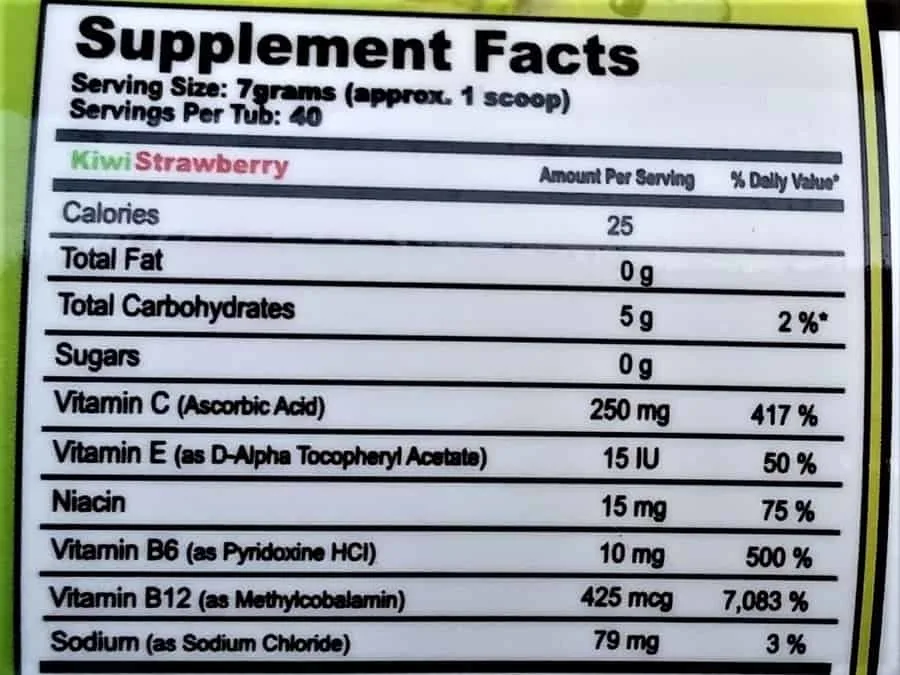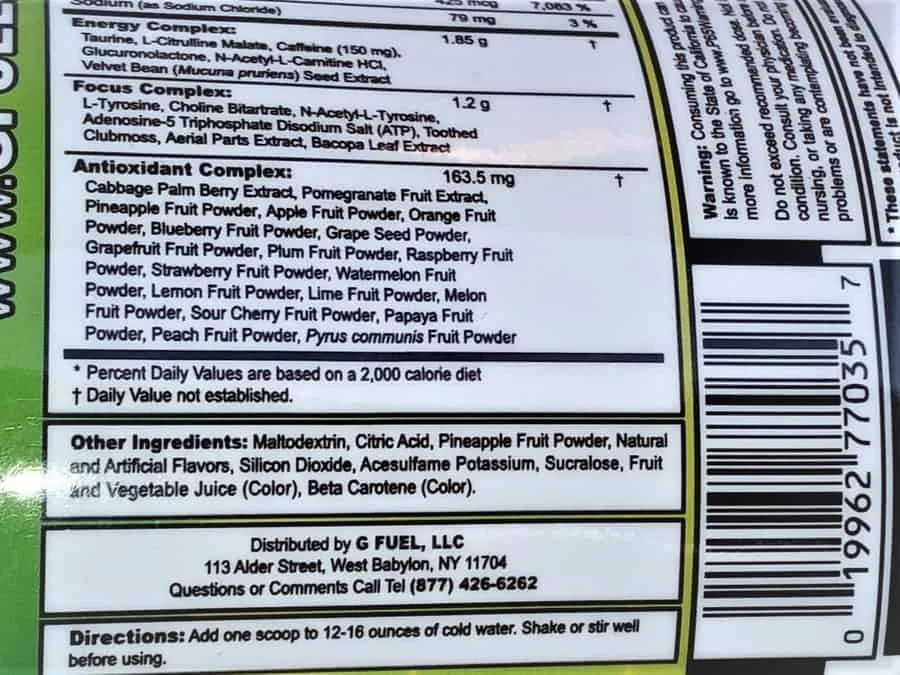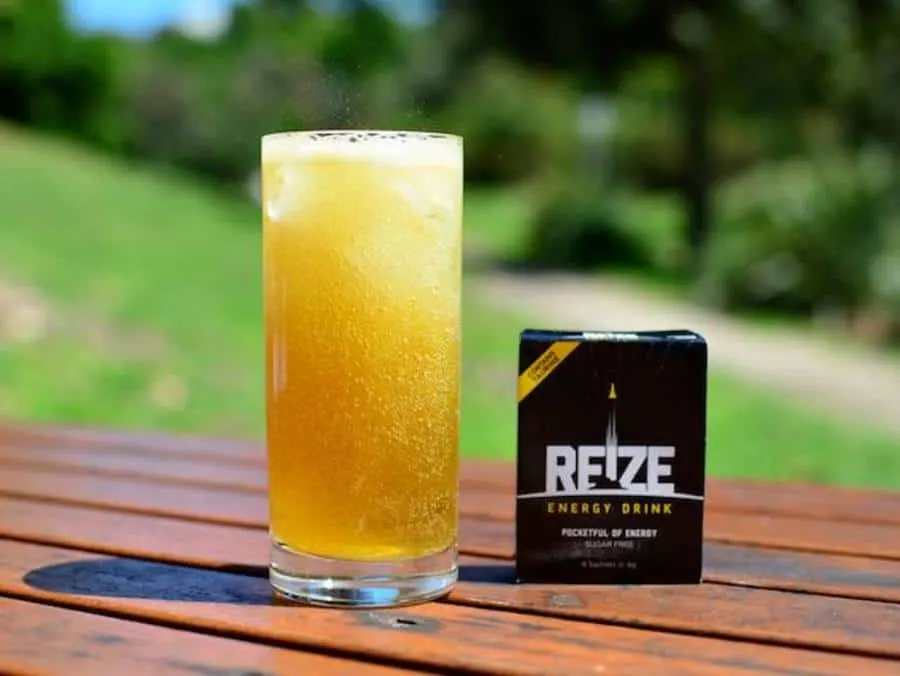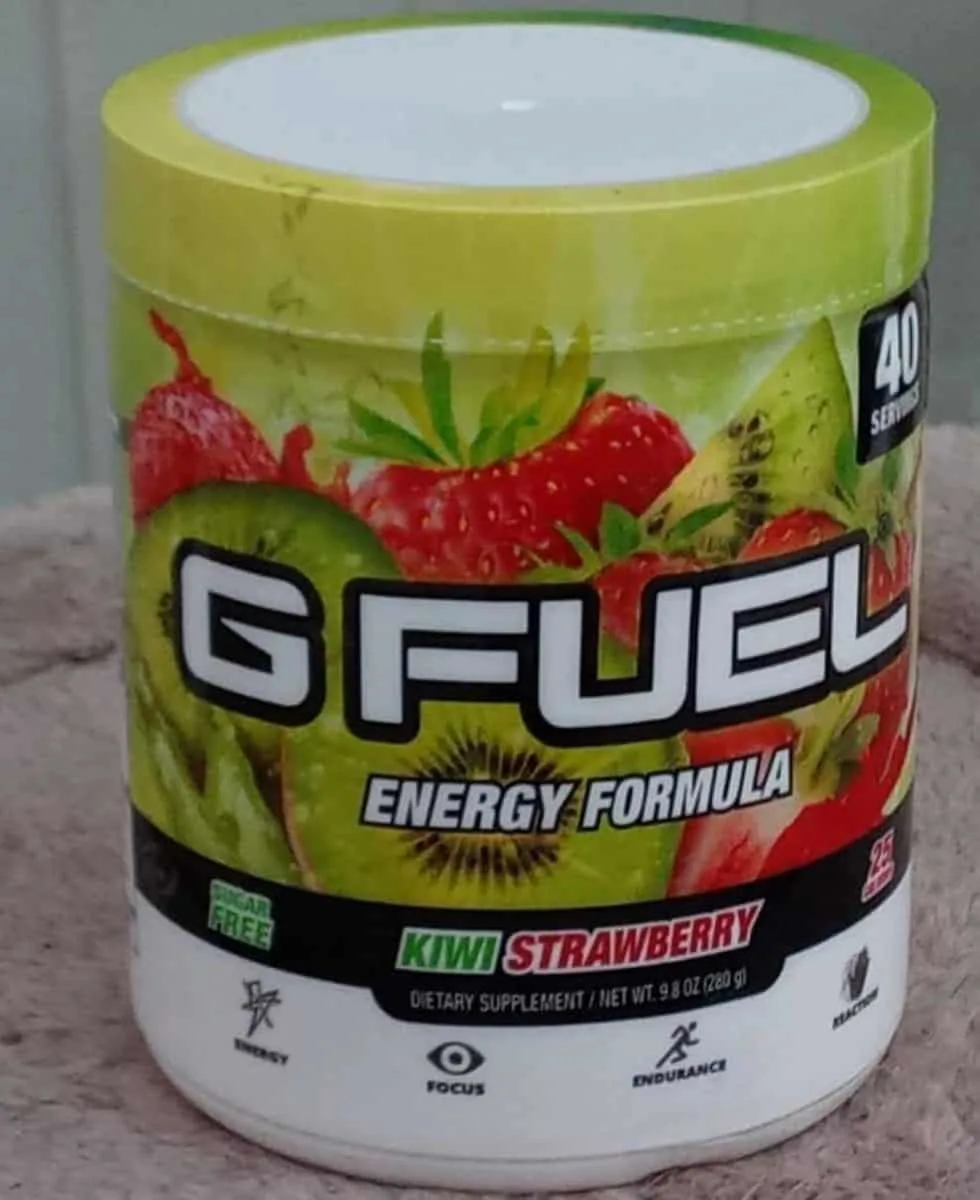G Fuel is one of the more popular powdered energy drinks on the market, with a reasonable price and plenty of flavors to suit your fancy.
While they definitely provide you with a quick boost, you may be wondering if it’s safe to drink G Fuel every day and not get any side effects.
In truth, as long as you don’t overdo it and strictly moderate your overall caffeine consumption, having G Fuel every day is harmless and may even be beneficial to you.
For a more detailed response, stick around to find out all you need to know about having G Fuel daily, from its nutritional aspects, to how all that caffeine might affect you in the long run.
Let’s get started…
G Fuel Nutrition Facts
Let’s have a look at a single serving of powdered G Fuel and how it fares against its pre-made, canned counterpart.
| Average Values | G Fuel Powder (7g) | G Fuel Can (16 fl.oz) |
| Energy | 25 calories | 0 calories |
| Fat (Of which Saturated) | 0g (0g) | 0g (0g) |
| Carbohydrate (Of which Sugars) | 5g (0g) | 0g (0g) |
| Sodium | 79mg | 70mg |
| Caffeine | 150mg | 300mg |
| Vitamin C | 250mg | 45mg |
| Vitamin E | 15IU International Units) | – |
| Vitamin B3 (Niacin) | 45mg | 4mg |
| Vitamin B6 | 10mg | 0.4mg |
| Vitamin B12 | 425μg | 0.6µg |

If you’re interested in learning more about Gfuel cans, I’ve got a great article with everything you need to know that you should check out.
How Many Calories Are In G Fuel?
With 25 calories per 7g serving, G Fuel Powder has a relatively low amount of calories for an energy drink.
G Fuel’s 25 calories is a significant dip compared to other popular energy drink brands such as Red Bull (110 calories per 8.4fl.oz) or Monster (240 calories per 16 fl. oz)
As a reminder, the daily recommended caloric intake for healthy adults ranges around from 2000 to 2400 calories for women and 2400 to 3000 calories for men.
As such, it’s pretty easy to work a regular serving of G Fuel into your diet without having to worry about the calories that come with it.
Plus, having some calories does give energy to your cells, it’s just that too many calories will result in weight gain, so it’s mostly a balancing act to have enough, but not too many.
However, if you’re not fond of calorie-crunching and want a simple zero-calorie energy drink instead, I’ve written an article on the best energy drinks in that category, which I’m sure you’ll find helpful.
G Fuel Ingredients
While I would usually list out the ingredients for simplicity’s sake, G Fuel has too many, so have a look at the image below instead, and I’ll discuss the more important ingredients further below:

How Much Caffeine Is in G Fuel?
Each 7g serving of G Fuel has 150mg of caffeine, which is about twice as much as you’d get from a regular 8.4-ounce can of Red Bull.
Considering that each 7g serving is mixed with 12 to 16 fl. oz of water (or less if you like your G Fuel more concentrated), the 150mg of caffeine is actually a pretty standard amount of caffeine in an energy drink.
While I personally prefer to have between 50 to 100mg of caffeine per serving, 150mg isn’t all that high that it would ruin the whole experience for me.
Depending on your caffeine metabolism, 150mg might be just the right amount for you. That said, due to the flexible nature of G Fuel, you can always adjust your G Fuel servings to what best suits you.
Remember, the FDA approves a caffeine intake limit of no more than 400mg per day. Any more than that might lead to side effects such as:
- Insomnia
- Restlessness
- Headaches
- Stomachaches
- Dizziness
- Dehydration
- Anxiety
So, be sure to watch how much caffeine you consume while having G Fuel. While a single serving may not be much, add that to a cup of coffee or a soda, and you might find yourself a bit more jittery than usual.
Is There Sugar in G Fuel?
G Fuel is entirely sugar-free but does contain artificial sweeteners, namely sucralose and acesulfame potassium.
One of the definite attractions of G Fuel is the absence of sugar in the drink, which means that G Fuel is entirely sugar-free.
This is great from a health perspective, as too much sugar in your diet can and will lead to some alarming consequences, such as:
- Weight Gain
- Type II Diabetes
- Increased risk of heart disease
- Tooth decay
- Kidney damage
- Acne
- Increased risk of depression
Now that’s not to say sugar is universally bad, just that when it comes to energy drinks, cutting back on sugar can’t be anything but a good thing.
Plus, you also get to avoid the dreaded sugar crash, which isn’t something you want out of any energy drink.
If you’re looking for other sugar-free energy drink options, I’ve written an article on the best energy drinks without the crash, which you’ll hopefully find useful.
Are There Artificial Sweeteners in G Fuel?
Although free of sugar, G Fuel does contain artificial sweeteners, namely sucralose and acesulfame potassium.
As zero-calorie sweeteners, both sucralose and acesulfame potassium don’t add much to G Fuel nutrition-wise but definitely do make the drink taste sweeter than it would be without sugar.
For a more in-depth look at what artificial sweeteners actually do, take a look at the video below:
Health-wise, since artificial sweeteners have been approved for general use by the FDA, they should be pretty safe to have as long as you have them in moderation.
How Long Does G Fuel Last?
Depending on your caffeine metabolism and how used you are to energy drinks, a single serving of G Fuel can last anywhere between 4 to 6 hours.
As for how long it takes for the effects of G Fuel to kick in, here’s what they claim on their website:
After consuming a full serving of G FUEL, it will take about 10-15 minutes for the desired effects to kick in.
G Fuel
So, G Fuel does act relatively fast though the boost you get from it may vary depending on if you’re a hardcore caffeine enthusiast or an undergrad looking to stay awake for a couple more hours.
However, I would say that there’s really nothing all that special or unique about G Fuel compared to other energy drinks. The effects all kick in at about the same time after consumption.
Generally speaking, you’ll feel the “maximum boost” about 45 minutes after drinking a caffeinated drink because that’s how long it takes for the caffeine to be fully absorbed into your blood stream.
Is G Fuel Good For Your Health?

In most cases, if consumed in moderation, G Fuel isn’t really bad for your health. On the contrary, you might even see an improvement in reaction time or general focus due to the caffeine present.
In cases when you need the boost (such as trying to wake up in the morning or during a crunch session), G Fuel can definitely provide you with a quick burst of energy to get you going.
However, having too much G Fuel will cause some lasting consequences, especially in the caffeine department.
Similar to how consuming numerous cups of coffee throughout the day is pretty bad (due to the caffeine), it’s also a bad idea to do the same thing with energy drinks such as G Fuel.
So, as long as you stick to having G Fuel in moderation, you should be perfectly fine.
I should also add that this assumes that you don’t have any pre-existing health conditions and the rest of your diet is healthy and balanced. If you’re unsure, check with your doctor about whether G Fuel is a smart decision for you.
How Many Servings of G Fuel Can I Have A Day?
| Per 7g serving of G Fuel | Daily Max Limit (Female/Male) | |
| Calories | 25 calories | 2400 calories/3000 calories |
| Sugar | 0g | 25g / 36g |
| Caffeine | 150mg | 400mg |
Based on its ingredients, I personally recommend that you have a max of two servings (14g) of G Fuel per day, as any more might lead to caffeine-related side effects.
Although it has a low-calorie count and no sugar in sight, a single serving of G Fuel does contain 150mg of caffeine, which is quite a lot.
Since 300mg caffeinated beverages such as Reign or Bang aren’t uncommon, you can definitely go with two servings per day if you need the boost.
Heck, even the ready-to-drink canned version of G Fuel contains 300mg of caffeine per can.
But considering how a single serving of G Fuel powder is enough to give you an energy boost for up to 4 to 6 hours, two servings a day might be a bit much unless you’re in for a full-day workout.
In any case, going over two servings per day is definitely a bad idea, as it’ll definitely put you over the FDA-recommended limit of 400mg of caffeine per day.
Remember, just because you can have more than two servings of G Fuel a day doesn’t really mean you should. I would recommend that you only have G Fuel responsibly with your caffeine intake in check.
Is It OK to Drink G Fuel Every Day?

As long as you don’t add in any other caffeinated beverages or pre-existing health conditions, having a serving of G Fuel a day should be perfectly fine.
Despite not having the same mass-market appeal as coffee, energy drinks such as G Fuel are a great alternative, giving you the caffeine boost you need without the bitterness associated with it.
That said, similar to all caffeinated beverages, moderation is definitely key.
Since G Fuel is a powdered energy drink, it’s definitely ideal to start out with a smaller serving and only increase it if you need that extra pep in your step.
Definitely don’t dive off the deep end and have two servings in your first go. That’s a recipe for disaster unless you have an overactive caffeine metabolism.
All in all, my advice is, to enjoy G Fuel responsibly, try not to have too many a day, and stick to only having G Fuel when you really need it.
What does G Fuel do to your body?
G Fuel is infused with “energy complex” ingredients designed to give you a good boost. This includes taurine, which is common in most energy drinks that is beneficial to your heart; citrulline, which reduces fatigue; and L-carnitine which help rebuild mitochondria and increases insulin sensitivity.
In addition, G Fuel also changes the process by which the brain produces serotonin and dopamine due to L-DOPA, a chemical found in mucuna pruriens, one of the components in this energy drink.
Moreover, G Fuel is also loaded with “focus complex” ingredients for improving focus. Still, they’re not scientifically proven to help with focus and memory but they seem to be safe.
Indeed, there is no denying that G Fuel is quite a powerful drink!
I have discussed more about what G Fuel does to your body in this article.
Can you drink G Fuel on an empty stomach?
You should drink G Fuel on an empty stomach can affect the stomach lining which can cause indigestion and heartburn.
Moreover, it can result in anxiety which can disrupt your focus on work. For that reason, you must have a full meal before consuming G Fuel or any other energy drinks.
Check out my article to know more about this matter!
G Fuel Alternatives
If you’re looking for other great energy drinks that are similar to G Fuel, here’s a quick list to get you started:
There are also some other great powdered options for you to consider too:
- Zipfizz
- Advocare Spark
- REIZE Energy Drink (my fav)
REIZE (10 out of 10)

G Fuel may be good, but I find REIZE to be even better.
Like G Fuel, REIZE is a convenient powdered energy drink. Each 4g sachet has a sensible 50mg of caffeine and is completely sugar-free, with only 11 calories per serving.
REIZE also contains other beneficial ingredients such as taurine, ginseng, and B-group vitamins, which all come together in a smart formula to give you the perfect energy boost without the crash.
The best part?
You can get REIZE shipped right to your door for only about $1 per drink, which is great value for money.
Try REIZE today, and I think you’ll agree that it’s a cut above G Fuel.

